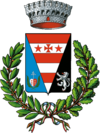Issime
| Issime | ||
|---|---|---|

|
|
|
| Country | Italy | |
| region | Aosta Valley | |
| Coordinates | 45 ° 41 ′ N , 7 ° 51 ′ E | |
| height | 956 m slm | |
| surface | 35 km² | |
| Residents | 405 (Dec. 31, 2019) | |
| Population density | 12 inhabitants / km² | |
| Post Code | 11020 | |
| prefix | 0125 | |
| ISTAT number | 007036 | |
| Popular name | Issimesi (Italian) Issimois (French) Eischemeyra ( Töitschu ) |
|
| Patron saint | James the Elder | |
| Website | Issime municipal administration | |
Issime ( Walser German Eischeme ) is a northern Italian municipality with 405 inhabitants (as of December 31, 2019) in the Aosta Valley .
Issime is the southernmost village in the historical Alemannic (West Upper German) language area and is separated from it by the neighboring French-Provencal-speaking town of Gaby . The population speaks or spoke traditionally Walser German as in the indirectly neighboring Gressoney , but the two dialects are so different that their speakers do not understand each other easily.
geography
The municipality belongs to the Union of Aosta Valley Walser Communities and is located in the Lystal on the Lys River , which in Pont-Saint-Martin into the Dora Baltea, which also flows through Issime .
Issime consists of the districts (in French and Töitschu ) Grand Praz (Gran Proa), Crest (Krecht), Chincheré (Tschentschiri), Bioley (Biouley), Seingles (Zéngji), Seingles Dessus (Ds uabra Zéngji), Plane (Pioani) ), Ribola (Ribulu), Vecchaus (Vetschus), Riccourt (Rickurt), Riccourt Dessus (Ds uabra Rickurt), Rollie (Rolji), Crose (Kruasi), Riva (Réivu), Preit (Preite), Tontinel (Tuntelentsch), Fontaineclaire (Funtrunkieeru), Chef-lieu (Duarf), Grand Champ (Gran Tschamp), Cugna (Künju), Nicche (Nicke), Zan (San), Ceresole (Di Zinnisili), Praz (Proa), Proasch (Proasch), Champriond (Tschendriun), Stein (Stein) and Riccard (Rickard) .
Languages and dialects
The Alemannic Töitschu has its origins with the Valais settlers - the so-called Walsers - who emigrated to the south around 1300. Compared to the dialect of Gressoney , Issime German has preserved many antiquities, but it was also influenced by the other languages spoken in the region (mainly Franco-Provençal , more recently also Italian ). It has numerous peculiarities such as monophthongization of Middle High German diphthongs ( e.g. mhd. Chuo > iss. Chuu 'cow') and diphthongization of Middle High German monophthongs ( e.g. mhd. Hûs > iss. Hous 'house'), which is not only different from Gressoney German, but sets itself apart from high and high Alemannic; In addition, the Töitschu is the only South Walser dialect that has not rounded the Middle High German rounded vowels (e.g. eat. pretty , pretty, not pretty as usual with the South Walsers ).
The languages of instruction in the school are Italian and French, so that the German dialect is still exposed to strong assimilation pressure. Very few children still speak the Walser German dialect. In the 2008/2009 school year, German was introduced for the first time at the schools in Issime and neighboring Gressoney, for which two German teachers were hired.
Numerous attempts are now being made to preserve the declining dialect. The Associazione Augusta is promoting Walser German, and the Centro Studi e Cultura Walser has compiled an Italian-issimedeutsches / issimedeutsch-Italian dictionary.
A 2001 survey by the Fondation Émile Chanoux showed that 61.33 % of the population had Italian as their mother tongue , the traditional vernacular Töitschu for 22.33% of the population.
literature
- Karin Heller, Luis Thomas Prader and Christian Prezzi (eds.): Lebendige Sprachinseln. 2nd edition, Bozen 2006. Online to Issime.
- Walser Kulturzentrum - Centro Studi e Cultura Walser della Valle d'Aosta (Ed.): D'Eischemtöitschu. Vocabolario Italiano-Töitschu. Gressoney St-Jean 1988. / Vocabolario Töitschu-Italiano . ibid. 1998.
- Peter Zürrer : Language island dialects. Walser German in the Aosta Valley. Aarau 1999 (= Sprachlandschaften series 23).
- Peter Zürrer: Language contact in Walser dialects. Gressoney and Issime in the Aosta Valley (Italy). Stuttgart 2009 (= ZDL supplement 137).
- Renato Perinetto: Eischemer's Büjie. San Valentino 1981. [Declination.]
- Imelda Ronco, Michele Musso: Eischemgseiti. Les dictions van a voart. Aosta 2007.
- Walser community Greschoney-Eischeme: Fiori e piante nella lingua Walser. Blljümi un bauma in Éischemtöitschu. Meie òn Bouma òf Greschòneytitsch. Dizionario illustrato, realizzato dal Comune di Issime. St-Christophe 2010.
Individual evidence
- ↑ Statistiche demografiche ISTAT. Monthly population statistics of the Istituto Nazionale di Statistica , as of December 31 of 2019.
- ↑ Isabel Zollna: The German in language contact - French and Provencal / German. In: Werner Besch, Oskar Reichmann, Stefan Sonderegger: Language history: a manual for the history of the German language. Pp. 3192-3202. On the Aosta Valley: p. 3196.
- ↑ Nicola Vicquery: Oberes Lystal - a Walser community in a rapid language change. In: Walser language. Progetto Interreg III B. 2nd study meeting in Brig, 9. – 10. June 2006. pp. 125-135. ( Memento from September 12, 2012 in the Internet Archive ) (PDF; 1.6 MB) p. 131.
- ↑ Nicola Vicquery (16 October 2009): Gressoney and Issime. Annual report (September 2008 - September 2009). Activities to maintain or promote the language. Walser regions - Aosta
- ↑ Émile Chanoux (born January 9, 1906, Rovenaud near Valsavarenche ; † May 18, 1944, Aosta), notary and anti-fascist politician, member of the Resistancea , died in Nazi-fascist imprisonment.
- ↑ Fondation Émile Chanoux , Sondage Linguistique, Résultats Vallée d'Aoste : The figures are based on the evaluation of 7,500 questionnaires. The survey took place in September 2001.


